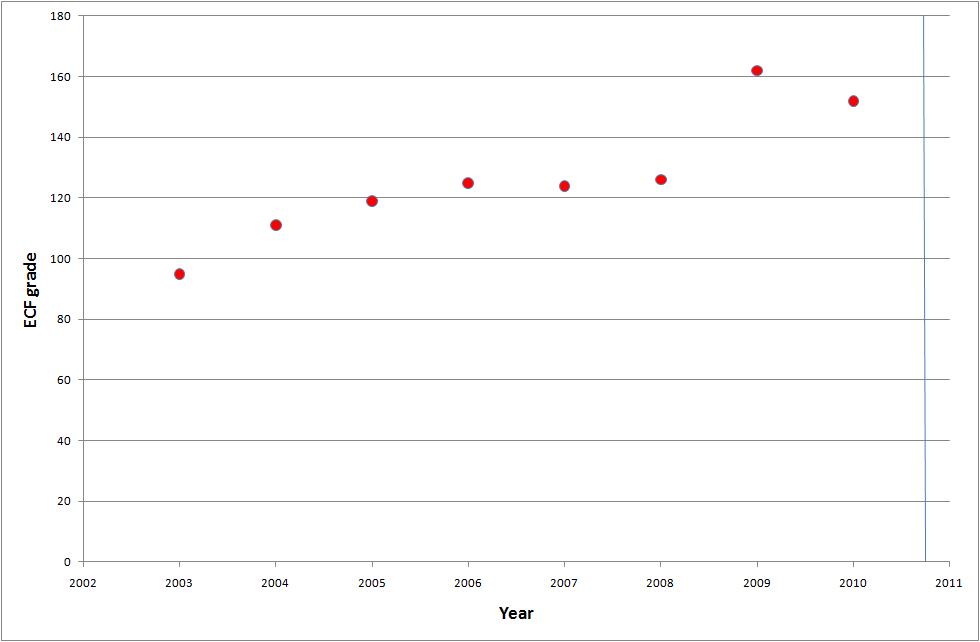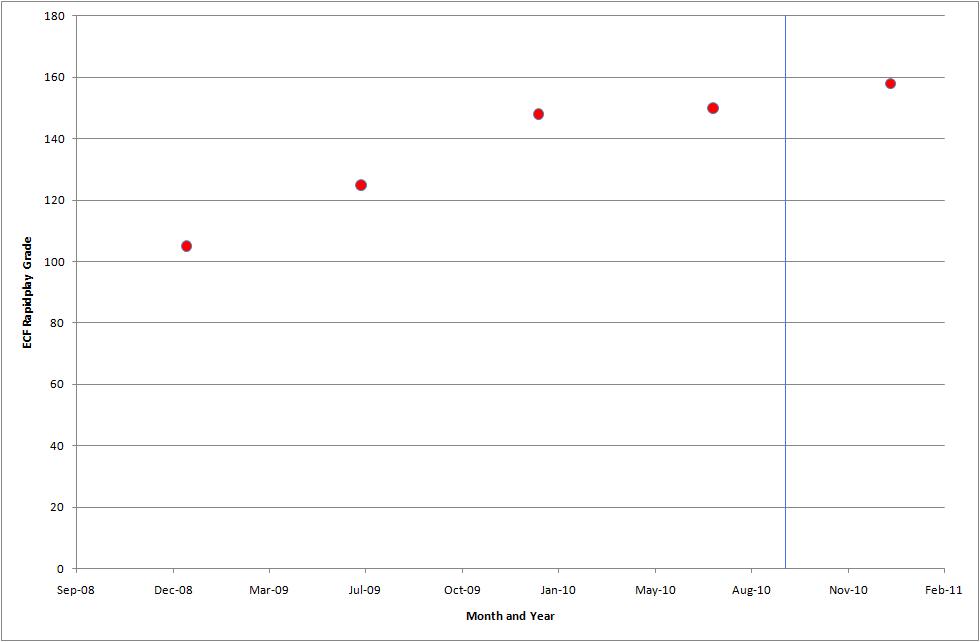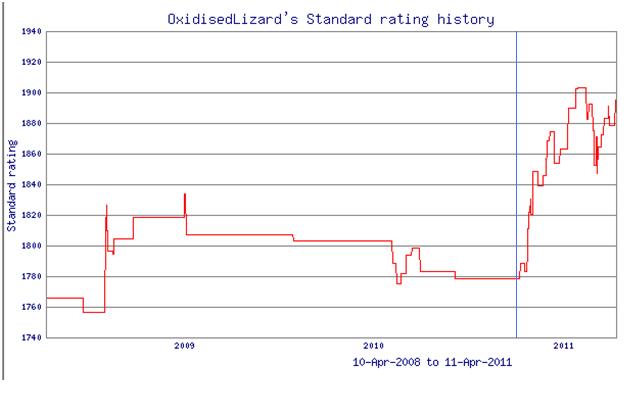This page shows my progress with a number of rating graphs. The vertical blue line on each represents the start of my Road to Grandmaster project.



This page shows my progress with a number of rating graphs. The vertical blue line on each represents the start of my Road to Grandmaster project.



Hey, I’ve just had a look at your ecf grade graph. My initial thought was that it wasn’t a particularly smooth trend :/ I generally find that the best way to establish steady grade progression is to enter lots of OTB tournaments and enter sections intelligently. For instance when I had a grade of 143 I would generally enter under 145 sections but occasioanlly majors and sometimes opens. This allowed me to get good at meticulously beating people at an under 145 level whilst still getting some experience of playing stronger opposition. Similarly now that I am 168 I generally enter under 170s with some opens thrown in. If previous years are anything to go by it will take until spring until I start being able to get 5/5 but it’s certainly something that has allowed me to keep my grade improving at a consistant rate. I hope that advice can help
Interesting idea there, but I think the idea of playing in open tournaments in the long run will be beneficial for Will, what he needs now is experience and skill ,results can come later.
After hes been playing with masters, his level of play should subconsciously get stronger, your recommendation is excellent in terms of rating preservation but Will, really can’t afford to amble around in ‘1700 land’ forever, keep up the open tournaments Will, for now rating doesn’t matter first get your strength up, desensitize yourself against 2200s because the skill of a GM is a lot higher than that! Your first check point is the CM title!!
My ACF ( Australian Chess federation rating) right now is 1925! so we both have lots of work to do!
IT IS RIGHTLY SAID “WHERE THERE IS A WILL THERE IS A WAY. I GUESS YOU NAME IS WIL IF NOT MISTAKEN. I HAVE GONE THROUGH SOME OF YOUR GAMES AND LET ME TELL YOU THAT YOU ARE NOT A BAD PLAYER. BUT TO BE A GRANDMASTER YOU GOT TO GO AND STUDY THE STRUCTURE OF EACH GAME OF EVERY OPENING. WHAT ARE THE E4 OPENINGS? DO YOU KNOW THEM ALL? WHAT IS STRUCTURE AND DO YOU STUDY THE SAME STRUCTURE TILL YOU ATLEAST DRAW THE GAME WITH GM LEVEL WITH THE GOOD SOFTWARE. TRUST ME. IT WORKS. ALSO PURCHASE AND STUDY MASTERING THE CHESS OPENINGS BOTH VOLUME 1 AND 2. COMPLETE END GAME FROM JEREMY SILMAN. YOU SHOULD KNOW ALL OPENING LINES LIKE TABLES.
Thanks for your comment. I think you have a good point – I don’t have a very broad opening knowledge, and having at least some understanding of many different structures would probably be helpful. However, basically I disagree – I think it’s much more important to have a deep understanding and knowledge of the few openings which you play almost all the time. Thanks for your book recommendations – I’ll have a look at the ‘Mastering the Chess Openings’ series, but I although I’ve heard good things about the Silman endgame book I already have two excellent general endgame books (Dvoretsky and Mueller/Lamprecht).
Endgame: Hi, just grab Silman Endgame even though you already have Dvoretsky & Muller. Dvoretsky is very good manual but a player may get intimidated, Muller is encylopediaic and better to read once you finished Dvoretsky. But Silman is assesible to anyone from beginner until master stregth. Yeah for your 1900 FIDE, you may feel that that books was too easy, but if you’ve time go to bookstore and try browse it first before you decide whether to buy or not. If you want real stuff read Nunn Chess Ending vol1 & 2 after finishing Dvoretsky/Muller/Silman
OPening: Below 2400, its better to get firm understanding about what is ‘in’ the opening PLUS the transformation opening/middlegame rather than memorise variation and sub variation. You can memorise in detail later.Recommended read: Watson’s Mastering chess opening Vol1,Vol2,Vol3 & Vol4 + Secret of modern chess strategy/ Modern Chess Strategy in Action also by Watson.
Middlegame/Positional: Silman’s how to reassess your chess 3rd edition AND 4th edition. Bear in mind Mr. Silman completely rewrite for 4th edition: mean that the 3rd and the 4th have completely different content.get both. If you;ve more buck, take Reasses your chess workbook and the Amatuer mind also by Mr. Silman. Amatuer mind?? dont underestimate it, yeah it is geared towards amatuer but i had learn a lot from it (btw, my rating 2000+ FIDE, that 3 years ago, inactive, because focus on training and I planning to play again this year.). To round up everything buy Silman’s Pal Benko book.
It seem that I always talk about Silman. BTW he just a retired IM right?! not even a GM. I tell you what, formerly, Im quite skeptical about book that written by non-GM, as if there are not qualified, but as time goes by, I get wiser. Its not who the author that matter most, but what you can get from that author. Even if the book written by Kasparov, but you cannot grasp the advanced concept laid by him, then it may not the correct time to read it.
Hi Wan,
Thanks for your suggestions. I may well follow your advice about getting the Silman endgame book to read before Dvoretsky, as Dvoretsky is certainly hard reading which would probably be made less painful by having a bit more endgame knowledge under my belt first. I agree with you about reading Muller after Dvoretsky.
I will look into the Watson works. My understanding and knowledge of openings I don’t play is currently poor to nonexistent, and I guess his opening series would help to change this.
Finishing Reassess your Chess is certainly high up on my to-do list for after exams. I currently only have the 3rd edition though. The only one of your suggestions I’m a bit puzzled by is the Pal Benko biography – I’m sure it has instructional value but would think it should only make my essential reading list if Pal Benko is a player whose style I particularly try to emulate.
Hi, why you dont have a FIDE rating yet?
Hi Jules, I do have a FIDE rating. This page is woefully out of date – I’ll try to get round to updating it soon.